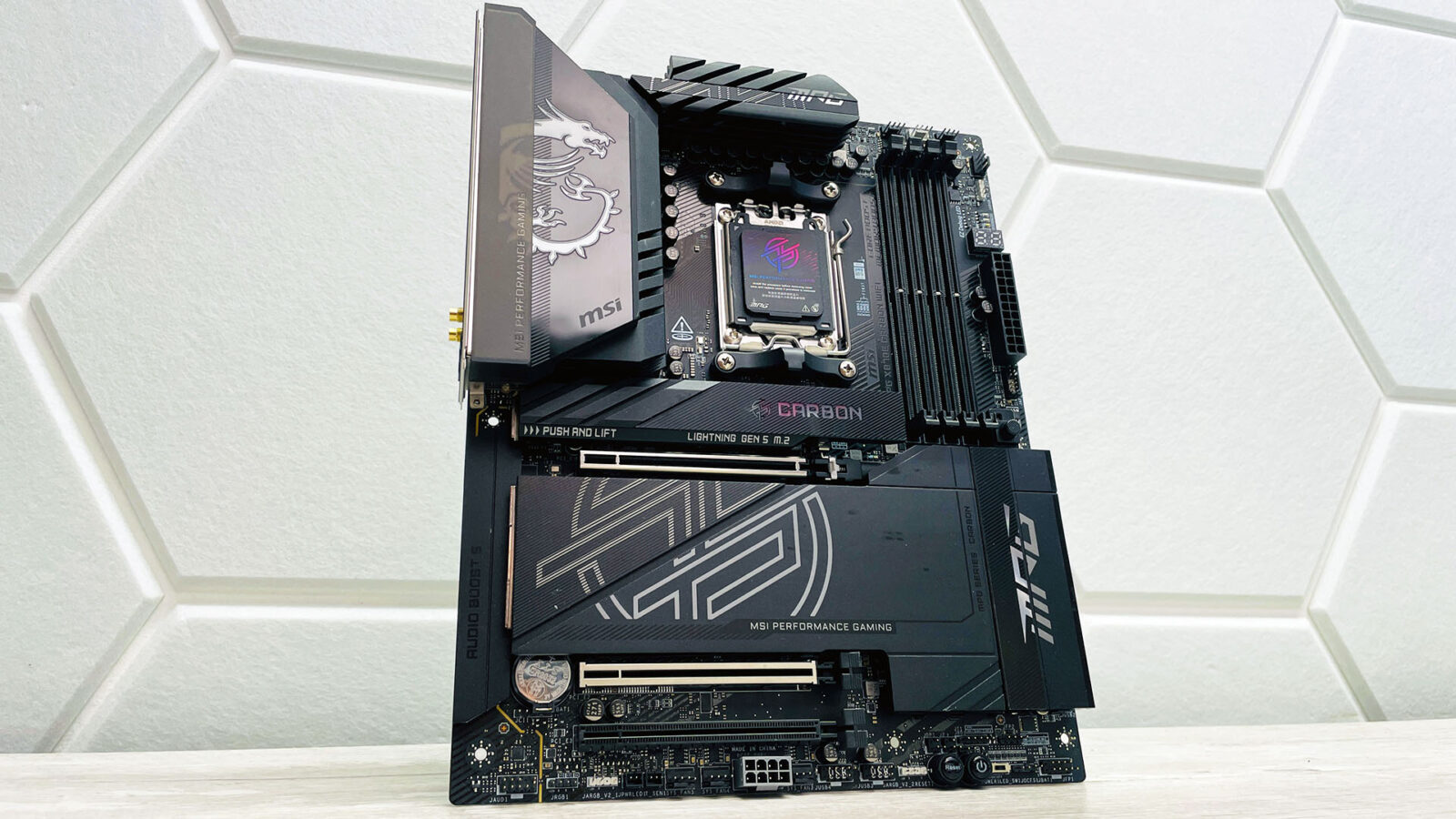Our Verdict
Extensive PCIe 5.0 support, Wi-Fi 7, a new EFI, tool-free features, and a big emphasis on high-speed I/O are all in the mix in this powerful AMD motherboard. The MSI MPG X870E Carbon WiFi price might be high, but it’s cheaper than many premium boards, and it’s largely justified by the feature set on offer.
- Good balance of high-speed USB ports
- Attractive design
- Lots of premium features
- Excellent SSD and GPU tool-free access
- Expensive
- Average Windows software
- No faster than cheaper boards
- Some features feel superfluous
With a price of $500, you’d be right to expect the MSI MPG X870E Carbon WiFi to look great, offer an abundance of high-end features, and generally leave you with little reason to lust after an upgrade until it no longer offers support for the latest processors. It’s the company’s most expensive MPG Carbon WiFi motherboard yet, and it certainly offers plenty of headline features, including Wi-Fi 7, USB 4, PCIe 5.0 SSD and GPU support, and a handsome appearance.
There’s a lot going on here in terms of what’s been crammed onto the PCB and, of course, there are the added benefits of the MSI MPG X870E Carbon WiFi using AMD’s best gaming motherboard chipset, X870E, rather than just the plain old X870 chipset. This gives advantages in terms of the number of high-speed USB ports and PCIe lanes available, meaning you’re less likely to need to watch out for SSDs stealing PCIe lanes from your graphics card, for example.
As well as kitting out this board with cutting-edge features, MSI has also given its EFI a makeover with a new HD interface and redesigned layout, and it certainly hasn’t cut back on other features either. You get plenty of overclocking and testing tools, and even thermal probe inputs that can feed into your fan speeds, which is useful for cooling specific areas of your PC, as well as with custom water cooling.
Why you can trust our advice ✔ At PCGamesN, our experts spend hours testing hardware and reviewing games and VPNs. We share honest, unbiased opinions to help you buy the best. Find out how we test.
Specs
| MSI MPG X870E Carbon WiFi | |
| Dimensions | 305 x 244mm |
| Chipset | AMD X870E |
| CPU socket | AMD Socket AM5 |
| RAM support | 4 x DIMM slots, max 256GB DDR5, up to 8,400MHz |
| Expansion slots | 2 x PCIe 5.0 16x, 1 x PCIe 4.0 16x |
| M.2 ports | 2 x M.2 PCIe 5.0 4x with heatsinks, 2 x M.2 PCIe 4.0 4x with heatsinks |
| External USB ports | 9 x USB-A 3.2 Gen 2, 2 x USB-C 3.2 Gen 2, 2 x USB-C 4.0 |
| Internal USB ports | 1 x USB-C 3.2 Gen 2, 1 x USB-A 3.2 Gen 1, 2 x USB-A 2.0 |
| Sound | Realtek ALC4080 |
| Networking | 1 x Realtek 2.5Gbps LAN, 1 x Realtek 5Gbps LAN, Wi-Fi 7, Bluetooth 5.4 |
| Fan headers | 7 x 4-pin |
| I/O panel | 2 x audio jacks, 1 x optical port, 1 x HDMI port, 1 x BIOS Flashback button, 1 x CMOS clear button, 1 x Smart button |
| RGB lighting | M.2 heatsink, I/O shroud, 3 x 3-pin ARGB |
| Extras | Thermistor cables |

Features
Let’s start with the tool-free features on this board, as they’re a big shouting point for all motherboard manufacturers at the moment. MSI has taken a similar route to Gigabyte, as we saw in the Aorus Elite X870 WiFi7 Ice, giving you a push-button release system for your graphics card.
Plus, like many 800-series motherboards, there are so many M.2 ports that this feature is essential, as you’d never be able to access the usual 16x PCIe graphics slot release lever otherwise. MSI’s tool requires you to press it once to release and again to close the latch once your graphics card is installed to lock it in place. That’s perhaps one step too many, but the mechanism is solid and leaves you in no doubt that your graphics card is secure.

The M.2 SSD heatsinks are also tool-free, with both featuring latches at one end that release or secure the entire heatsink without any need for extra tools, while the SSDs themselves are also held in place by more tool-free latches.
However, at the other end of the heatsinks are pins that guide and secure them into place, and these proved tricky to line up, especially on the larger lower heatsink. By contrast, Gigabyte leaves these guide pins exposed so you can see exactly how to line up the heatsinks, but you’re working blind with the heatsinks here and it can be a little tricky.
The MSI board’s rear I/O panel is also definitely an eye-catcher compared to previous generations, with no fewer than four USB-C ports. Two of these are USB-C 4.0 and also double as DisplayPort outputs, while the other two are USB 3.2 Gen 2, topping out at 10Gbps. MSI still manages to cram in a further nine USB 3.2 Gen 2 Type-A ports, though, so we doubt anyone will find themselves wanting when it comes to USB ports on this board, now or in the future.

In addition, the panel also has both 2.5Gbps and 5Gbps Ethernet ports, plus buttons for USB BIOS Flashback, CMOS clear, and Smart buttons, with the latter able to be reassigned to various tasks, such as resetting the PC or altering the RGB lighting.
Meanwhile, the Realtek ALC4080 audio codec is essentially the same as the older ALC1200-series codecs instead, but it’s now run off the USB bus. It otherwise has similar specifications and isn’t considered an upgrade despite the higher model number. This audio system outputs to two 3.5mm audio jacks, plus an optical output.

As you’d expect on a board at this price, you also get power and reset buttons on the PCB, as well as an LED POST code display, which is useful for AMD boards since they can take a while to POST thanks to memory training and other features, so it’s handy to know your board is still booting and not frozen, especially if you’re overclocking your system.
There are seven 4-pin fan headers as well, plus three thermal probe inputs, and the fan headers here are much better-placed than those on Gigabyte’s Aorus Elite X870 WiFi7 Ice too. What’s more, all four M.2 ports are cooled above and below using thermal pads and heatsinks, with two of them supporting the latest PCIe 5.0 M.2 SSDs.

Design
If you’re looking for a black motherboard equipped with modest RGB lighting then you’re in luck, and I also applaud MSI’s nifty engineering on the top M.2 heatsink. This has a press-together connection for its RGB lighting, and that lighting also extends to the I/O shroud and a trio of 3-pin RGB headers.
The layout is also excellent, despite the feature-rammed PCB, and promotes easy cable tidying, especially when it comes to fan cables, as the headers are all located at the edges of the PCB. My only complaint here concerns the slightly tricky heatsinks I mentioned earlier, plus MSI could have hidden the unsightly CMOS battery from view, perhaps under one of the heatsinks.
Meanwhile, the design of the new EFI is appealing and, as usual, MSI has excellent overclocking and fan control sections, while the Windows-based software is also improved. The latter is still far more clunky to use than the EFI, although it can be useful for fine-tuning your fans in stress tests.

Benchmarks
The MSI MPG X870E Carbon WiFi managed similar Cinebench scores to the Gigabyte Aorus Elite X870 WiFi7 Ice, with a marginally slower single-core score of 138, but a higher multi-core score of 2,389.
In Total War: Warhammer 3 at 1080p its minimum 99th percentile and average frame rates of 159fps and 220fps were on par with the Gigabyte Aorus Elite X870 WiFi7 Ice too, with the average being 10fps higher. The audio performance was similar as well, with a noise level of -99dBA and a dynamic range of 104dBA.
The top SSD slot saw our PCIe 5.0 SSD get a little toasty at the end of our stress test, sitting at 78°C, but this fell to 70°C using the PCIe 5.0 slot under the larger lower heatsink so we recommend using that one for a PCIe 5.0 drive.
Meanwhile, the 18+2+1 phase VRMs recorded a peak temperature of 63°C, which gives you a reasonable amount of headroom if you plan on overclocking, while the system as a whole drew a little more than the Gigabyte Aorus Elite X870 WiFi7 Ice, at 373W versus 361W.

Price
The MSI MPG X870E Carbon WiFi price is $500, making it one of the cheaper X870E motherboard options out there, but it still represents a sizeable investment. Given that cheaper boards are just as fast, many will find the premium compared to cheaper options better spent on a more powerful graphics card or CPU, or even one of the best gaming SSD options.
Those cheaper options include older B650 and X670 motherboards, all of which support the latest Ryzen 9000 CPUs, including the 9800X3D, as well as B850 motherboards that will be doing the rounds soon too.
This board does have nearly all the features you’d want from a high-end motherboard, though, and offers a degree of future-proofing as a result, as well as plenty of scope for handling the latest flagship hardware. With that in mind, if you have a sizeable budget and want your motherboard’s features to still be relevant at the end of the decade, then the MSI MPG X870E Carbon WiFi is definitely worth considering.

Alternatives
Gigabyte Aorus Elite X870 WiFi7 Ice
You don’t need an expensive board based on the X870E chipset to build a great Ryzen 9000 system, which is proved by this excellent Gigabyte motherboard based on the cheaper X870 chipset. It doesn’t offer as much in terms of PCIe 5.0 and high-speed USB support, but it still covers most people’s needs, while also looking fantastic.
If you’re looking to build a white PC, then this superb white motherboard will look great in your white PC case, and it doesn’t cost too much money either.
Read our full Gigabyte Aorus Elite X870 WiFi7 Ice review.
Verdict
Ultimately, what was once an affordable mid-range board now retails for twice the price of its predecessor based on the X570 chipset. MSI’s MPG Carbon lineup has become much more high-end in the process, though, and this motherboard does offer an excellent set of future-proof features, as well as good looks. It wouldn’t look out of place in one of the best gaming PCs with a Ryzen 9 9950X and RTX 4090 strapped to it, and come January that’s likely to be an RTX 5090 and Ryzen 9 9950X3D, of course.
Thankfully, it does at least have the credentials to deal with those components, as well as all manner of other high-end options, such as custom water cooling, and, just as importantly, it has cutting-edge features that are likely to become mainstream in a few years’ time. It’s expensive, certainly, but if you plan to build a gaming PC with a high-end spec, and want a motherboard with features that won’t be out of date in three years, it’s worth the investment if you can afford it.
If you’re thinking of building a new AMD Socket AM5 system, make sure you also check out our Ryzen 7 9800X3D review, where we benchmark the current best gaming CPU. You can also check out our guide on how to overclock the 9800X3D, which we performed using this exact motherboard, so you can see some of the EFI features in more depth.












Leave a Reply